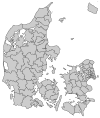Læsø
 | |
| Geography | |
|---|---|
| Location | Kattegat |
| Coordinates | 54°47′N 11°06′E / 54.783°N 11.100°E |
| Area | 101 km2 (39 sq mi) |
| Administration | |
| Demographics | |
| Population | 1,969 |
| Pop. density | 19.5/km2 (50.5/sq mi) |
Læsø ("Isle of Hlér") is the largest island in the North Sea bay of Kattegat, and is located 19 kilometres (12 mi) off the northeast coast of the Jutland Peninsula, the Danish mainland. Læsø is also the name of the municipality (Danish, kommune) on that island. The island is a location mentioned in several instances in Norse mythology, including as the dwelling of the sea jötunn Ægir and as a feasting place of the Norse gods, the Æsir.
Etymology
Modern Danish Læsø is first attested in Old Norse as Hlésey, meaning "Isle of Hlér". According to the Prose Edda book Skáldskaparmál, Hlér is another name for the sea jötunn Ægir who, according to the same book, there held feasts for the gods.[1]
The Municipality of Læsø
The municipality is in Region Nordjylland in northern Denmark. The municipality, Denmark's smallest, covers Læsø and neighboring small islands for a total area of 114 square kilometres (44 sq mi), and has a total population of 1,969 as of 1 January 2010.[2][3] Its mayor is Olav Juul Gaarn Larsen, a member of the Venstre (Liberal Party) political party.
The main town and the site of its municipal council is the town of Byrum.
Because Læsø is an island and lies in the Kattegat, its neighboring municipality, Frederikshavn on the Jutland peninsula, is separated by water, the Læsø Rende, from the island municipality.
Ferry service connects Frederikshavn on the Jutland peninsula to the municipality at the town of Vesterø Havn while Østerby Havn is the island's fishing harbour.
Læsø municipality was not merged with other municipalities by January 1, 2007 as the result of nationwide Kommunalreformen ("The Municipal Reform" of 2007).

Location, industry, and wildlife
Together with Anholt, Læsø belongs to the Danish "desert belt"; during the summer months there is so little rain that streams and ponds partly dry up.
In the Middle Ages, the island was famous for its salt industry. The ground water can reach over 15 percent salt, and this was naturally concentrated in flat salt meadows during the hot dry summers. The final concentration, carried out in hundreds of salt kilns, consumed large amounts of wood. Eventually the island became deforested, sandstorms buried villages, and salt extraction was banned. Since the end of the 1980s it has been resumed on a small scale as an archaeological experiment and a tourist attraction.
Læsø is home to the bee subspecies European dark bee. The species is protected by Danish law which prohibits the import of other species to the island. The law has not been enforced and today normal bees and brown bees are both used for the production of honey. The island has been split in two parts for bee management, one for each species.
Læsø is home to unique styles of Danish traditional music. Most of it is not played any more but has been preserved through intense documentation and research in the 1980s and 1990s.
Residents
The island is home to the noted chef Mogens Bay Esbensen.
Norse mythology
In the Poetic Edda poem Hárbarðsljóð, the god Thor comments that it was on Hlésey that he was attacked by and so fought "berzerk women" or "brides of berzerks" who had bewitched all of the men on the island. Thor details that, upon beaching his ship, the women battered it, threatened him with iron clubs and chased his servant, Þjálfi:
- Benjamin Thorpe translation:
- She-wolves they were, and scarcely women.
- They crushed my ship, which with props I had secured,
- with iron clubs threatened me, and drove away Thiâlfi.
- What meanwhile didst thou, Harbard?[4]
- Henry Adams Bellows translation:
- She-wolves they were like, and women little;
- My ship, which well I had trimmed, did they shake;
- With clubs of iron they threatened, and Thjalfi they drove off.
- What, Harbarth, didst thou the while?[5]
These "women" are either personified waves or jötnar. The island is also a setting in the poems Helgakviða Hundingsbana II and Oddrúnargrátr, the saga Örvar-Odds saga, in two skaldic kennings, and the aforementioned (see etymology section above) Prose Edda book Skáldskaparmál.[6]
See also
Notes
- ^ McKinnell (2005:110) and Faulkes (1995:59).
- ^ "Læsø Kommune", Den store Danske. Template:Da icon Retrieved 28 June 2010.
- ^ "Danmarks Statistik." Retrieved 28 June 2010.
- ^ Thorpe (1866:76).
- ^ Bellows (1923:92).
- ^ McKinell (2005:110).
References
- Bellows, Henry Adams (Trans.) (1923). The Poetic Edda. New York: The American-Scandinavian Foundation.
- Faulkes, Anthony (Trans.) (1995). Edda. Everyman. ISBN 0-4608-7616-3
- McKinnell, John (2005). Meeting the Other in Norse Myth in Legends. D.S. Brewer. ISBN 1843840421
- Thorpe, Benjamin (Trans.) (1907). The Elder Edda of Saemund Sigfusson. Norrœna Society.
External links
- The municipality's official website
- Municipal statistics: NetBorger Kommunefakta, delivered from KMD aka Kommunedata (Municipal Data)
- Municipal mergers and neighbors: Eniro new municipalities map

